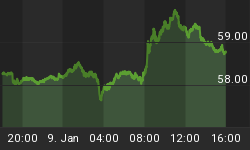The economic data continues to drip weaker. Today's Chicago Fed index was the lowest since 2009, and while the Dallas Fed index rose, it remains negative. These aren't major indicators, but the general tone of data recently has been weak and nothing recently stands out as positive...except for Existing Home Sales, which raises other issues as noted last week. A friend in the southwest U.S. describes the local housing market in Phoenix as "definitely bubblicious" and passed along this link, describing how rental properties in Phoenix are seeing aggressive bidding from would-be renters.
Now, economic activity is also not exactly falling off a cliff, and some Americans insist that the economy is doing just great (these seem to be the Obama voters but I can't tell which way the causation runs - are they Obama voters because they think the economy is doing well, or do they think the economy is doing well because they are Obama voters and that's the story?). But to listen to Fed speakers, you would think economic collapse is imminent. Last week, Minnesota Fed President Kocherlakota[1] advocated keeping monetary policy extraordinarily accommodative until the unemployment rate gets down to 5.5% or until the medium-term outlook for inflation rises above 2.25% (on core PCE). Today, San Francisco Fed President Williams said that he expects the Fed to end asset purchases "before late 2014" (which, for those of you scoring at home, would imply the Fed has about a trillion dollars to go) and shouldn't raise rates until mid-2015. I wonder what it is that Fed officials are forced to check at the door: their brains, or their optimism?
No wonder that inflation-linked bonds are so expensive these days!
Which brings me, actually, to the main topic I wanted to discuss today. A reader asked me the other day about I-series savings bonds from the U.S. Treasury. For those of you who aren't familiar with them, I-bonds are like regular savings bonds except that they pay a real interest rate. That is, instead of getting a fixed coupon, you get a fixed coupon plus inflation, which is added to the principal and compounded until the bond is redeemed. You can buy them on Treasury Direct and keep them in electronic form, and in fact that's the best way to buy them. You can buy up to $10,000 per Social Security number per year.
And that limit turns out to be a good thing, because if it weren't for that limit hedge funds would be going nuts on series I bonds right now. Because the people who created I bonds never contemplated a negative real interest rate, or else thought the marketing angle of selling bonds at a negative real interest rate would be too bad, the fixed part of the I bond coupon is floored at 0%. This is significant, since the market rate for a 5-year TIPS bond right now is -1.59%. The coupon rate on the I-bond is set for the next six months of new sales (the fixed coupon stays the same for the life of any given bond) every May and November, and typically is set very close to the 5-year TIPS rate (see chart below, source Treasury Direct and Bloomberg).

Notice, though, that at the far right-hand part of the chart the last few I-bonds issued have had coupons of 0%, since the actual TIPS rate has been considerably below that. And that means that if you are going to buy TIPS, then before you spend a single dollar on the April-2017 TIPS you should buy your full $10,000 limit on I-bonds, because you save 1.59% compounded for at least 5 years. That's an extra 8.2% total return on your money over that period![2]
Occasionally, there can be good deals when the TIPS market moves between the setting of a coupon and the next coupon set. When the current series coupon was set at zero, back in May 2012, the advantage was only about 125bps and it's now 159bps. But the current advantage is in good measure structural, rather than due to timing. As a consequence of that structural mistake (not allowing a negative real coupon), combined with the TIPS market's rally since May, the current spread is actually the highest ever seen for the program (see chart below, source Treasury Direct and Bloomberg).

I don't regularly recommend specific trade ideas in this (public) space, for a whole host of regulatory reasons, but I can say this: look into series I-bonds unless you (a) don't care about inflation, (b) feel like you need to take lots more risk, (c) feel comfortable that if you wait long enough, you'll get a better investment opportunity in inflation-linked bonds, or (d) have so much money that $10,000 per member of your household, per year, simply isn't meaningful.
And if it's case (d), then please write because I need more friends like you!
[1] Kocherlakota is described by some as a hawk, but he can most accurately be described as ‘confused.' He once explained that the Fed might have to raise interest rates, even if inflation expectations were low, to force them higher, getting the causality exactly backward.
[2] Note that if you do not intend to hold the I-bond for at least 5 years, there is a penalty associated with early redemption - you lose some interest accrual. Even with that, it's not a terrible deal given how cheap these are now, and most investors should have some inflation protection in their portfolios to diversify the risk of all of those investments (equities, nominal bonds) that do poorly in inflationary environments. So, for the buy-and-hold part of your portfolio, these are terrific.















